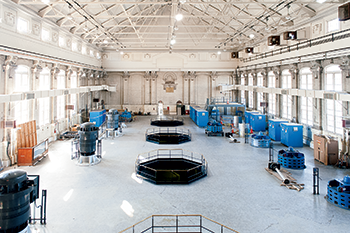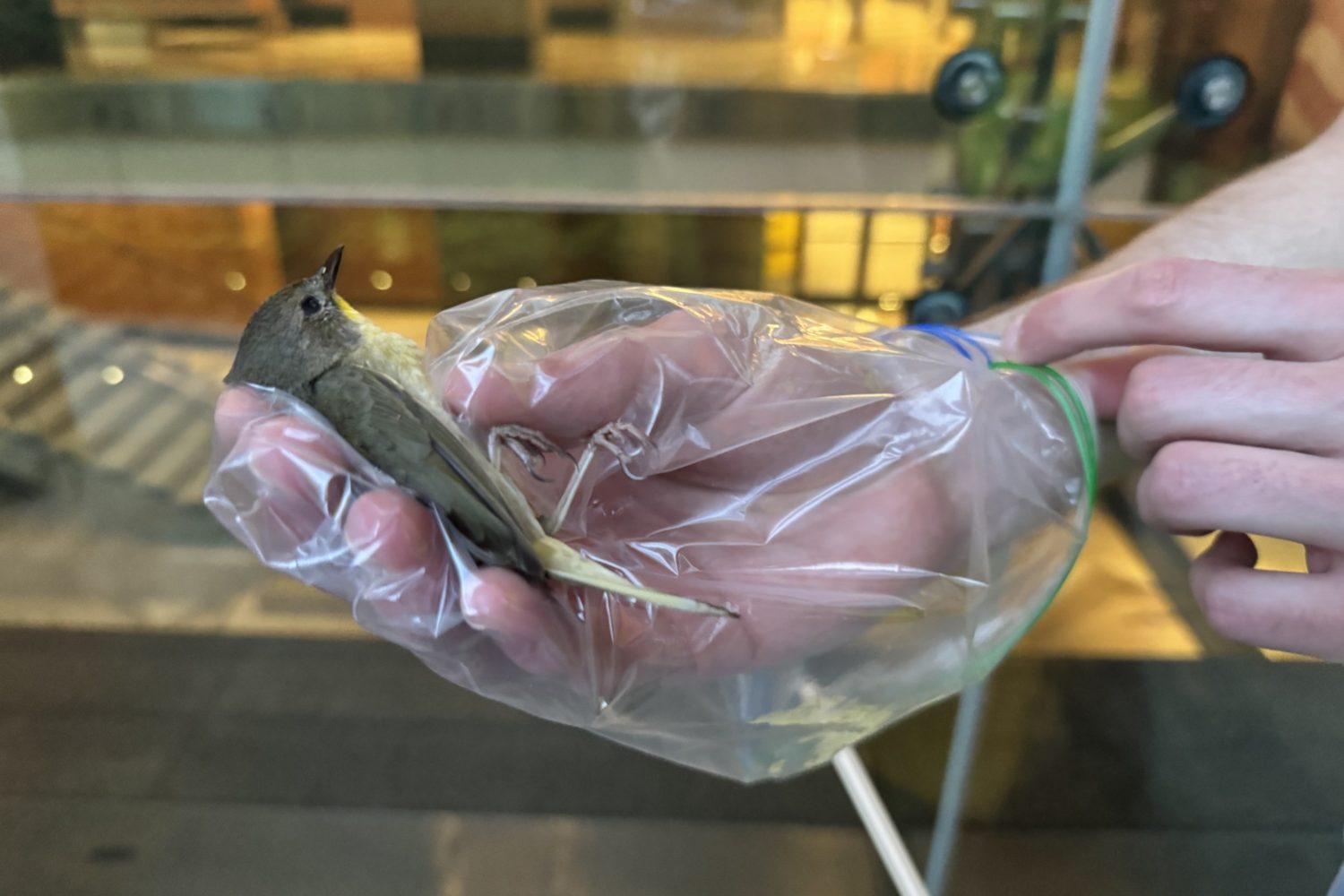
Though it bears one of DC’s loveliest place names, Blue Plains—located at the District’s southern tip—stinks like a sewer. On 153 unlovely acres, wedged between the Potomac River and the Anacostia Freeway in Southwest DC, is the Blue Plains Advanced Wastewater Treatment Plant, the daily recipient of some 370 million gallons of toilet flushings and other effluent from the District as well as parts of Maryland and Virginia. The odor from the open tanks and storage towers is pervasive—and distracting. “Eau de Blue Plains, I call it,” says Maureen Holman while giving a tour.
A petite, assertive 37-year-old lawyer with dark, curly hair tinted red, Holman is DC Water’s program manager for sustainability. Blue Plains’ smell, she says, “doesn’t really faze me.” She cites a stint early in her environmental career as an animal keeper at the Academy of Natural Sciences, a museum in Philadelphia. “Fifty percent of my job involved poop,” she says. “It takes a lot to gross me out.”
Holman is different from the rest of us, too, in that the facility occupies a large share of her waking thoughts. Most Washingtonians don’t think much about Blue Plains—though were it to stop operating, it would be pretty much the only thing on our minds.
Holman’s primary role at DC Water is to prevent that from happening, despite multiple threats from the planet.
Blue Plains sits at the lowest point in the District (gravity, after all, is good for water flow) and is frighteningly vulnerable to flooding. The high water that swept into Washington in 1936 and again in 1942 reached the Jefferson Memorial. In 2003, a storm surge from Hurricane Isabel that inundated the Washington Navy Yard was staved off with sandbags and an emergency crew in the control room around the clock.
But there’s no guarantee those structures would withstand weather that seems to be growing increasingly weird and unpredictable—as Hurricane Sandy demonstrated so dramatically.
“Sandy was a very, very shocking and sort of eye-opening event,” Holman says. In October 2012, water managers up and down the East Coast watched with concern as the hurricane shut down New Jersey’s largest water-treatment plant, flooding its systems and spewing 3.8 billion gallons of sewage into Newark Bay. Other water facilities stayed relatively dry but lost power and were offline for weeks. The state reportedly expects to spend some $2.6 billion to rebuild and shore up its drinking water and sewage-treatment infrastructure.
Which prompts a question: What if Sandy had turned west earlier and taken a track up the Chesapeake Bay?
“You lose Blue Plains,” Holman says. “I mean that there is no treatment—for weeks and weeks and weeks on end.”
• • •
Blue Plains looks like a place readying for battle. Cranes tower over a muddy sea punctuated with earth-moving equipment. At the southern end, a 17.2-foot sea wall is being put in place, high enough, when it’s done in 2021, to hold back a 500-year flood, plus an extra three feet.
Though, again, nobody can be sure how climate change will affect these plans. On another chilly February day, Holman stood on a grassy patch next to DC Water’s main pumping station, in a beautiful (on the outside) Beaux Arts-style building dating to the early 20th century. After Blue Plains, it’s the utility’s most vulnerable facility, sitting on a spit of land next to the Anacostia River, a block from Nationals Park. The river, encrusted with ice, along with a fair number of plastic cups and other garbage, looks well behaved.
“We’re standing on a 100-year flood plain,” Holman says, explaining that this is a Federal Emergency Management Agency estimate indicating a 1-percent chance that the area will be flooded in a given year—though that figure is based on historical data, without factoring in a potential global rise in sea levels. Some scientists predict that seas in the Chesapeake region will rise anywhere from two to five feet by 2100.
Says Holman: “Climate change basically throws a huge wrench into the analysis.”
A year ago, DC Water general manager George Hawkins asked Holman to develop a master plan that would guide the utility’s response to a warmer, wetter world. What Holman comes up with will have to accommodate a dismaying number of demands from a range of constituencies—from the utility’s 2.2 million ratepayers to environmental activists to government regulators.
Holman already spends a great deal of her time speaking to community groups and coordinating with local and national agencies and other utilities on their climate-change efforts and emergency-response plans. Those include dealing with flooding on the Mall, an area that’s actually sinking. Holman also heads an internal climate-change task force, formed last fall, that makes sure information is being shared and projects are properly prioritized within DC Water.
“For us, climate change is not a theoretical question,” Hawkins says. “It’s a practical, real-life, day-to-day operational question.”
Holman notes that before Hawkins steered her toward the issue, “climate change wasn’t something that was discussed at DC Water,” in part because the sheer amount of variables can be overwhelming: “When you don’t have the most modern, robust system to start with”—DC’s sewer system includes pipes installed when Abraham Lincoln was President—“how do you just throw more problems on top of it without kind of losing your mind?”
• • •
Holman grew up in Delran, a small town in central New Jersey. As a child, she adopted a manatee, by mail—she jokes that she’s always been “a tree-hugging environmentalist who doesn’t like nature.” As she explains it: “I have a lot of allergies, and I’m incredibly accident-prone.”
She graduated from the University of Southern California with a degree in environmental studies and dreams of working for a zoo or in wildlife rehabilitation. But in her three years at the Academy of Natural Sciences’ Live Animal Center, her allergic reactions to the furry creatures grew so severe she was forced to quit.
Reevaluating her approach, Holman attended the University of Georgia law school, earning a certificate in environmental ethics on top of a law degree. She moved to Washington to take a job as a program analyst in the city administrator’s office and then the District Department of the Environment (DDOE). It was there she met Hawkins, a Harvard Law grad with a long career in environmental issues who put her to work studying DC Water’s water quality and storm-water management.
When Hawkins was recruited to head DC Water in 2009, Holman spent four months as interim director of DDOE before joining Hawkins at Blue Plains—a move that felt at the time like a defection. “I was actually a little leery,” she says. “It wasn’t necessarily the most ‘kumbaya’ of relationships.”
You might think that staffing one of the most polluting agencies with career environmentalists would result in some serious kumbaya. But Holman and her boss have faced off recently with both regulators and water watchdogs.
About one-third of the city’s system consists of combined sewers: They carry both waste-water and storm-water runoff—a common engineering solution in 19th-century American cities that becomes problematic when it rains. Low-lying neighborhoods—such as the District’s Bloomingdale and LeDroit Park, near Howard University—have had to deal with repeated sewage backups. About 75 times a year, usually during heavy rains, the sewers become overwhelmed and we end up with about 2 billion gallons of untreated effluent flowing into our long-unswimmable rivers, then out to the Chesapeake Bay.
During a visit to the historic main pumping station, Holman points out an attractive pedestrian walkway over part of the river, noting large gaps among a few of the supporting pillars. Those, she says, allow room for the combined sewers’ outfall pipes, where sewage overflow is released. There are 52 more spots like this along the Anacostia and Potomac rivers and Rock Creek. “That’s why you see those lights over there,” Holman says, turning toward a tall structure on the pumping station’s grounds decked out with a set of orange-ish lights known as CSO (for combined sewer overflow) event-indicator lights. When they’re lit red, Holman explains with a wry smile, “it means there’s going to be some unpleasantness coming into the water.”
“It’s appalling,” says Matthew Logan, president of the environmental watchdog group Potomac Riverkeeper. Logan lists the E. coli, nitrogen, and other pollutants DC residents flush away and forget: “It’s basically Third World conditions.”

Under pressure from regulators to reduce overflows, DC Water has launched the Clean Rivers Project, which will spend $2.6 billion to construct a series of storage tunnels to catch some of the overflow, then release it slowly through the system. But this past February, the agency announced that it wants to scale back the costly “gray infrastructure” plan—that is, make the tunnel system less extensive—in favor of “green infrastructure”: expanding the area of permeable surfaces to absorb the excess rainfall and stop 96 percent of the overflow.
The new plan, which needs approval from federal and city regulators, would also allow the utility to spread the cost over a longer period, with a completion date of 2032, preventing a rate spike (though rates are already trending upward).
The 96-percent solution, Logan points out, “still leaves millions of gallons of sewage a year” flowing into local rivers. His solution would be to build both maximum tunnel capacity and the green infrastructure: “It’s only going to get worse as we get more storms.”
Hawkins, who’s fiercely proud of his team’s green efforts, says eliminating overflows entirely is unrealistic from a cost perspective and with weather patterns seemingly growing more unpredictable: “No matter what you build,” he says, “it may not be big enough to take that next huge, extreme storm if it dumps enough rain on you.”
• • •
Some environmentalists are more ready to give DC Water credit for its efforts. One activist, a former DDOE colleague of both Holman and Hawkins, says that without an environmental sensibility at the top, DC Water “could just as easily say we’re just cleaning up waste water—we’re not here to save the world.”
And with its current leadership, DC Water is moving steadily toward a greener future. The utility’s new five-story headquarters, to be built atop the O Street pumping station in Southeast DC—Holman calls it “my baby”—is still in the earliest stages, but she expects the new building to be certified platinum, the highest rating from the Leadership in Energy & Environmental Design (LEED) program, with alternative energy and innovative storm-water-management features. It may be finished by mid-2017.
DC Water, the largest user of electricity in DC, is building its own cutting-edge power plant at Blue Plains, so it will be less vulnerable to Pepco outages. The plant is also intended, according to Hawkins, to take the utility off Pepco’s grid by the 2020s.
“It’s still sort of baby steps,” Holman says. “It’s not something where I can wave a big plan around and point to it—although I hope to eventually get to that point. What we’ve managed to do over the last year or two is to make climate change a part of the conversation here.”
Local freelance writer Christina Ianzito can be reached at cianzito@gmail.com. This article appears in the April 2014 issue of Washingtonian.



















